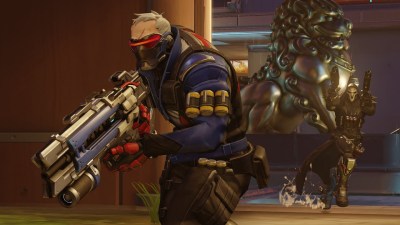Metal Gear Solid for the first PlayStation was a game changer when it was released in 1998. It pushed the boundaries of what people thought was possible with 3D graphics, and showed that the medium was capable of telling a deep and engaging story with compelling characters. Nearly two decades later, the game remains an experience you owe yourself to play; not only if you want to get into the franchise, but also want to experience first-hand a piece of videogame history. Metal Gear Solid V: The Phantom Pain is on the way of course, and the groundwork for that game has already been laid by the release of Ground Zero‘s prologue (which we recently reviewed). So with Metal Gear fever once more at a peak, what better time than to start working our way back through the series by way of Retrospective Reviews?
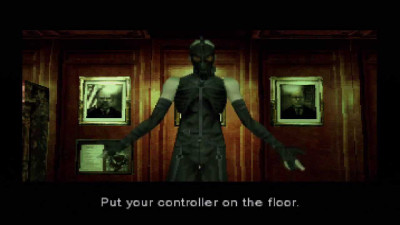 The story of Metal Gear Solid appears to be fairly simple at first; you play as Snake, a legendary soldier tasked with infiltrating a nuclear weapons facility on shadow Moses Island, where a group of terrorists are demanding the US government hand over the remains of the legendary mercenary Big Boss. If the US refuse, the terrorists will launch a nuclear attack on US soil. Needless to say, things become infinitely more complicated as you encounter other characters, some of whom had a hand in creating a certain weapon which Metal Gear fans will be familiar with, along with other characters that featured in the original MSX Metal Gear, which released in 1987.
The story of Metal Gear Solid appears to be fairly simple at first; you play as Snake, a legendary soldier tasked with infiltrating a nuclear weapons facility on shadow Moses Island, where a group of terrorists are demanding the US government hand over the remains of the legendary mercenary Big Boss. If the US refuse, the terrorists will launch a nuclear attack on US soil. Needless to say, things become infinitely more complicated as you encounter other characters, some of whom had a hand in creating a certain weapon which Metal Gear fans will be familiar with, along with other characters that featured in the original MSX Metal Gear, which released in 1987.
What’s perhaps most surprising about Metal Gear Solid’s story - at least, at the time of its original release - is the themes it chooses to cover. Anti-war, nuclear deterrence, and the human cost of conflict are all explored. And while it may not always do so with much restraint or subtlety - the line, “can love bloom on the battlefield?” felt cheesy rather than profound 16 years ago, let alone in 2014 - it’s still impressive to see a game tackle issues that hold a great amount of reverence.
That’s not to say the game doesn’t have moments that are deliberately ridiculous; you fight a group of super soldiers known as FOXHOUND, some of which possess powers that seem ripped out of comic books, and are utterly bizarre: Psycho Mantis is a levitating, gas-mask adorned psychic with a penchant for reading the player’s memory card and manipulating the vibration capabilities of the then-recent Dualshock controller; Decoy Octopus is a master of disguise who goes so far as to even inject his subject’s blood into his vein; and Revolver Ocelot is a fan of Spaghetti Westerns with uncanny marksmanship skills and a penchant for torture. Each gets their time in the spotlight, and each encounter is as memorable as the last.
Despite their strangeness however, you may find yourself feeling guilty after dispatching these boss-like characters; upon their defeat, the story of how they came to be are laid bare, and adds an impressive amount of humanity to these 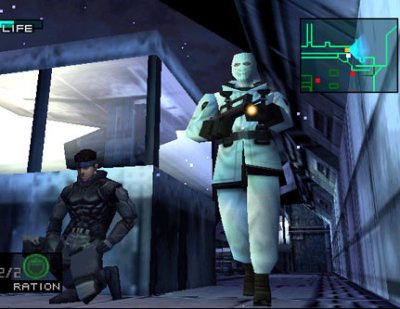 seemingly inhuman characters. While Kojima’s script can often be ridiculously overwrought, scenes like these demonstrate that he’s also capable of tremendous pathos. The idea of a group of bizarre and superhuman foes is one that Kojima would revisit in every subsequent game, often with great success (the Cobra Unit of Metal Gear Solid 3: Snake Eater was a particular highlight). But none of these subsequent creations have quite managed to have the same kind of lasting impact that FoxHOUND had on players.
seemingly inhuman characters. While Kojima’s script can often be ridiculously overwrought, scenes like these demonstrate that he’s also capable of tremendous pathos. The idea of a group of bizarre and superhuman foes is one that Kojima would revisit in every subsequent game, often with great success (the Cobra Unit of Metal Gear Solid 3: Snake Eater was a particular highlight). But none of these subsequent creations have quite managed to have the same kind of lasting impact that FoxHOUND had on players.
Revisiting the game now though in light of nearly a decade and a half of evolution in the medium, and some aspects of the game have dated worse than others. There’s that aforementioned script, which sees the tone of the game veer wildly between seriousness, ridiculousness and incidents of breaking the fourth wall. At first, the game appears to be taking things rather seriously with colonial Campbell explaining the situation to Snake in an almost movie-like fashion; but later you watch a grown man wet himself from fear after being discovered hiding in a locker.
Meanwhile, Kojima’s love of exposition-heavy dialogue may have arguably reached its zenith in Guns of the Patriots, playing Metal Gear Solid for five minutes only to be forced to sit through yet another lengthy codec conversation, still manages to break the immersion as control is wrested from the player.
This may sound jarring - and it certainly is at first - but when these moments of silliness work, they break up the constant talk of nuclear deterrence and stop another acronym from confusing you, offering a welcome break from these often bloated exposition-ridden cutscenes.
Performances from the host of voice actors is impressive and stands up remarkably well to this day, with the obligatory British-sounding villain rounding off an eccentric cast of characters whose lines are all delivered with enthusiasm and often feel as though the cast of voice actors were all too aware of the silliness of their lines and decided to play it for laughs. The codec - a staple of the series - is of course here, and allows you to call a host of characters who are there to support you on your mission. It’s an incredibly unique mechanic and features an impressive amount of dialogue, as you can use it at almost any time, for hints on where to go next or simply to hear their reactions on what just happened.
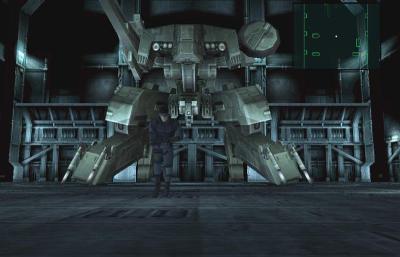 This constant connection to other characters makes your mission feel all the more vital, with a host of other characters working behind the scenes to help you. The codec also gives the game some funny ways to justify game elements such as saving, with a specific character you have to talk to in order to save. It’s silly and weird, but also undeniably charming and unique, and central to one of the most memorable examples of breaking the fourth wall in gaming history: about halfway through the game, you’re required to tune in to a certain frequency on your codec in order to progress. Many players found themselves stumped as they searched high and low for the frequency, only to come up empty-handed. More than a few assumed that the game was bugged, rendering progress impossible. But, in a brilliant move, the answer was hidden in plain sight - on the back of the game’s box, where a seemingly innocuous screenshot showed the required frequency clear as day.
This constant connection to other characters makes your mission feel all the more vital, with a host of other characters working behind the scenes to help you. The codec also gives the game some funny ways to justify game elements such as saving, with a specific character you have to talk to in order to save. It’s silly and weird, but also undeniably charming and unique, and central to one of the most memorable examples of breaking the fourth wall in gaming history: about halfway through the game, you’re required to tune in to a certain frequency on your codec in order to progress. Many players found themselves stumped as they searched high and low for the frequency, only to come up empty-handed. More than a few assumed that the game was bugged, rendering progress impossible. But, in a brilliant move, the answer was hidden in plain sight - on the back of the game’s box, where a seemingly innocuous screenshot showed the required frequency clear as day.
The gameplay holds up surprisingly well, although the controls are certainly an example of an era long gone. Being a stealth game means that stealth is, of course, the primary focus of the game, and you will be spending most of your time staying out of the cones of vision of the enemy, which are helpfully displayed on the mini map on the top right. In fact you will be spending a lot of your time looking at the mini map, as it displays often critical information, with not only enemies and cameras cones of vision displayed, but also the location of mines and other traps. You can choke enemies out, hide in a cardboard box and if you find a silencer, take out your enemies without alerting the others. It’s certainly not easy, with the security cameras in particular being borderline annoying at times. One area sees you walk up a flight of stairs with cameras that have guns attached, and while there is an item that temporarily disables cameras, the fact that there was no other way around meant that if you had none left, you would be unable to progress; so save regularly. The boss fights meanwhile, are numerous and often clever and often make up for the instances where the game’s design betrays its age.
The controls however are challenging for the wrong reasons; when you push yourself against the wall it’s all too easy to slip out of cover, and when you aim down the scope of a sniper rifle, it takes an absurd amount of time to get from one side of the screen to the other thanks to the under-sensitive response settings. The controls in general feel out of date, which is of course to be expected, but even at the time they felt awkward. Playing it now and that awkwardness is simply magnified tenfold.
Progression is similar to that of a metroidvania-style game, but instead of using new powers to open up new areas, you have security cards with varying levels of clearance. These security cards allow you to open up new areas not only to 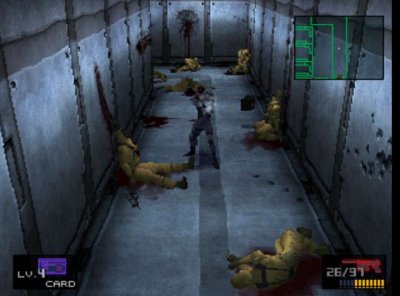 progress, but often to collect additional weapons and items hidden in previous areas. It can sometimes feel like too much backtracking at times, but when you return to a previously inaccessible area it’s certainly satisfying and helps the mission and gameworld feel like a connected one, instead of scattered and uneven. The result is that Shadow Moses Island feels like a coherent and believable space, as much a character in the game as the eclectic assortment of freaks and special agents that make up Kojima’s cast.
progress, but often to collect additional weapons and items hidden in previous areas. It can sometimes feel like too much backtracking at times, but when you return to a previously inaccessible area it’s certainly satisfying and helps the mission and gameworld feel like a connected one, instead of scattered and uneven. The result is that Shadow Moses Island feels like a coherent and believable space, as much a character in the game as the eclectic assortment of freaks and special agents that make up Kojima’s cast.
Graphically speaking; the game is certainly out of date at this point; you can probably count the number of polygons in snakes character model, and textures appear as a blurred mess. But this doesn’t take away from the games artistic design. Characters still manage to look unique and distinct, with nice touches such as unique body language and condensation visible when characters are outside in the cold. While environments are often blocky in appearance, they feel perfectly in keeping for a government science facility, and give off the appropriate tone of danger, relief and tension. The camera, on the other hand, is sometimes unwieldy during gameplay; it often produces some cinematic flair and tension, as the numerous and long cutscenes play out - betraying Kojima’s love of cinema - but during the moment-to-moment gameplay, its fixed perspective can often obscure the action or lead to moments that can create a disconnect between the direction Snake is moving on screen, and the direction you’re pressing on the controller.
The sound work holds up well, however. There’s the aforementioned voice acting - far superior to Silicon Knights’ remake on Nintendo’s Gamecube, Twin Snakes - and the musical score is as enjoyable to listen to now as it was back in 1998. Many of the sound effects have gone on to be iconic of the franchise, such as the sound cue of enemies spotting you, the chirpy tones of the codec, right down to the noises made when selecting an item in the inventory.
All in all Metal Gear Solid is still a surprisingly enjoyable experience. Sure the controls feel almost comically wrong, and the dialogue can be a bit long winded for its own good. In a time where boss fights and seemingly strange characters and stories are all but extinct in big budget games, it’s refreshing to play a game with unique ideas and concepts at every turn.


